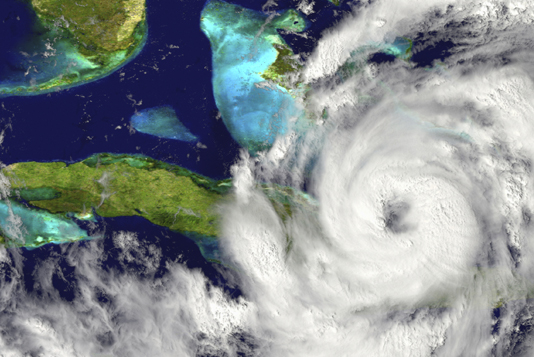
Put simply, a hurricane is a rotating, organised system of clouds and thunderstorms. According to James Dodgson, Deputy Director at the Bermuda Weather Service, it is a warm-core, non-frontal area of low pressure, with organised deep convection (a source of cloud, rainfall and thunderstorms) and a closed surface wind circulation around a well-defined centre.
Let me explain.
Hurricanes originate over tropical or subtropical waters, with a sea temperature of 26 degrees Celsius or more. The warm water is what fuels a hurricane. This is why hurricane season is busiest in Bermuda in late summer, when the waters surrounding us are the warmest.
A storm begins when a disturbance, such as thunderstorm activity, develops low atmospheric pressure over warm water. Warm air moves towards the low pressure and rises. As the air rises, it cools and starts to condense, which causes cloud and rain to develop. As this process continues, the low pressure deepens, increasing the speed of movement of the air into it and churning up the waters beneath it.
The air also rotates due to the Earth’s rotation, a process known as the ‘Coriolis Effect.’ In the Northern Hemisphere storms rotate counterclockwise; in the South they have a clockwise spin.
As a storm picks up speed and strength, it can develop a near calm, clear centre where air is drawn in at a high altitude and then sinks. This centre is called the ‘eye’ of the storm.
Before becoming a hurricane, a storm may start as a tropical depression with maximum sustained winds of 34 knots (63 km/h) or less. A depression does not have an eye.
A tropical storm has maximum sustained winds of 34-64 knots (63-119 km/h) and does not usually have an eye.
A storm becomes a hurricane when maximum sustained winds reach 64 knots (119 km/h). Hurricanes are categorised according to their strength: Category 1 is 64-82 knots (119-153 km/h), Category 2 is 83-95 knots (154-177 km/h), Category 3 is 96-112 knots (178-208 km/h), Category 4 is 113-136 knots (209-251 km/h) and Category 5 is 137 knots (252 km/h) or higher. Anything Category 3 or greater is considered a major storm.
Mr Dodgson explains: “Each hurricane comes with its own unique threats, based on the history of its development including where it is coming from, how long it took to form and how large it is.” Even a small tropical storm can pack a punch, so it is important to be prepared. Local warnings and watches during the season are available at www.weather.bm, www.nhc.noaa.gov.
In advance of hurricane season, work with your insurance company to ensure your policies are up to date and that they provide the coverage you need.







